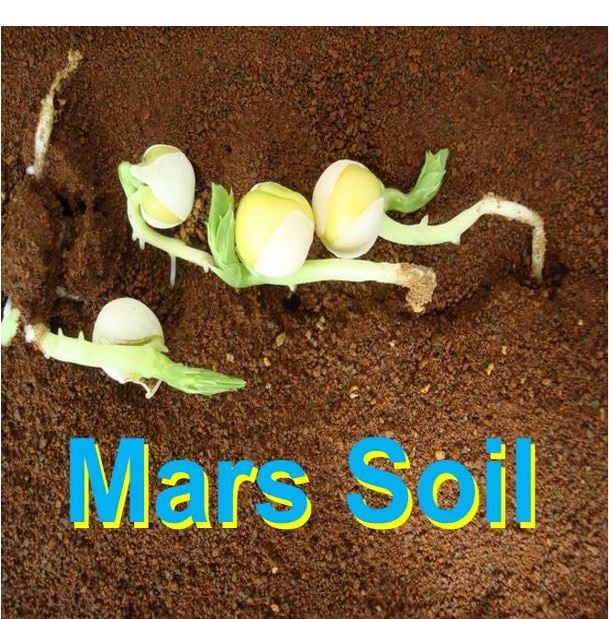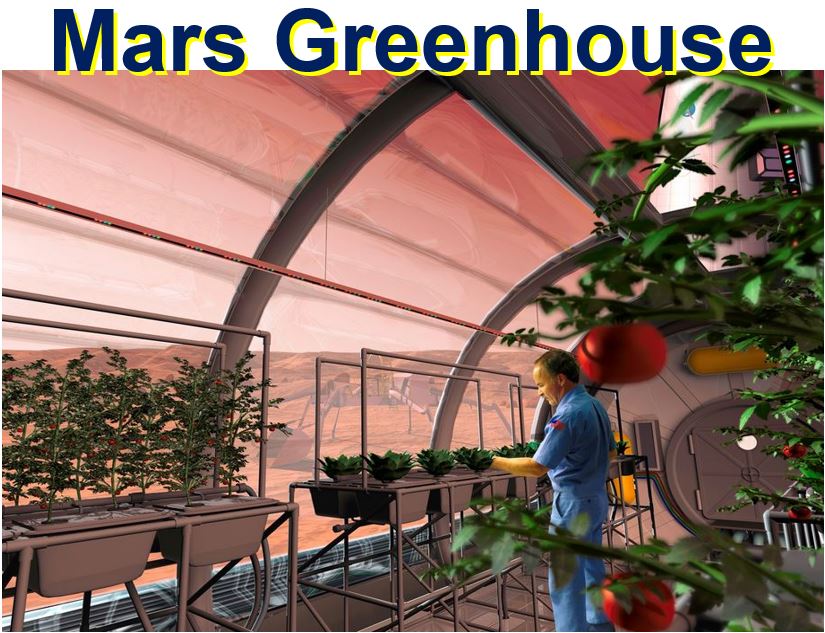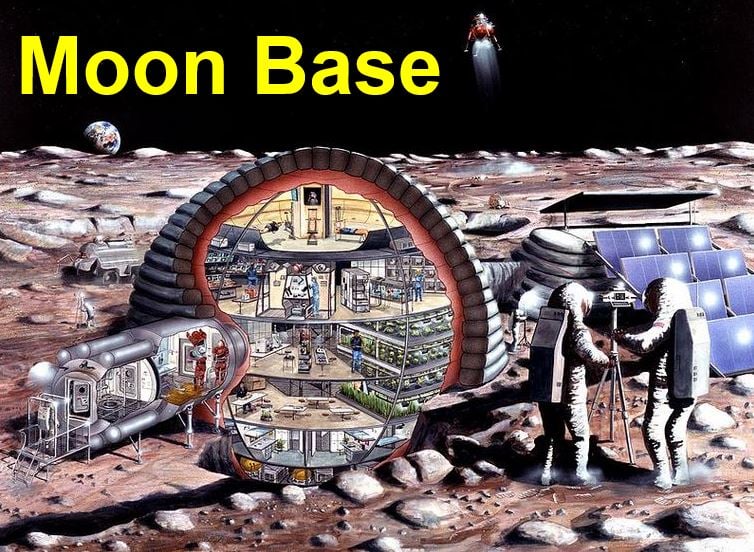Mars soil is good for growing ten different crop species, say surprised scientists from Wageningen UR (University & Research centre) in The Netherlands, after carrying out an extensive experiment using simulated Mars and Moon soils provided by NASA, and comparing the yields to plants grown on compost from Earth.
They managed to successfully grow garden cress, radish, garden rocket, rye, peas and tomatoes almost as if they were using potting compost from Earth.
The Martian movie story could happen
There is a Hollywood movie directed by Ridley Scott starring Matt Damon – The Martian – in which a stranded astronaut uses his botanical skills to cultivate potatoes on the Red Planet and consequently survives. That fictional story could become reality.
 Wageningen University wrote: “The ecologist [Dr. Wamelink] is questioning whether these plants and fruits are safe to eat. This is an important question, given that Martian and lunar soils contain high concentrations of heavy metals such as lead, cadmium and arsenic. Whether the plants contain any trace of these poisonous substances is as yet unknown.” (Image: Wageningen UR)
Wageningen University wrote: “The ecologist [Dr. Wamelink] is questioning whether these plants and fruits are safe to eat. This is an important question, given that Martian and lunar soils contain high concentrations of heavy metals such as lead, cadmium and arsenic. Whether the plants contain any trace of these poisonous substances is as yet unknown.” (Image: Wageningen UR)
Head of the University’s Mars Moon plant growth experiment, Dr Wieger Wamelink, said regarding the simulated Mars soil versus Earth potting compost:
“The total above ground biomass produced on the Mars soil simulant was not significantly different from the potting compost we used as a control.”
The aim of the Mars Moon plant growth experiment is to determine whether it is possible to grow crops on Mars and on the Moon in order to feed the astronauts and pioneer settlers.
From pots to trays
The researchers say they have made some improvements since the first experiment.
 An artist’s rendering of a greenhouse on Mars where vegetables can be grown. NASA and other space agencies may eventually decide to build them underground. (Image: nasa.gov)
An artist’s rendering of a greenhouse on Mars where vegetables can be grown. NASA and other space agencies may eventually decide to build them underground. (Image: nasa.gov)
Dr. Wamelink explained:
“We used trays instead of small pots and added organic material (fresh cut grass) to the Mars and moon soil simulant.”
“This solved the problem we had with watering in the first experiment and also added manure to the soils.”
Crop growth improved considerably after the Moon soil simulant was added to the mix. In the first Moon soil experiment the majority of the plants perished, while in the latest round they flourished and thrived.
In this latest experiment, the scientists were able to harvest from the same species as on the Mars soil simulant and the Earth potting compost control.
Fantastic potential
The total vegetable mass (biomass) from crops harvested in the Mars soil simulant was lower than the Earth control, however, the difference was not significantly different, i.e. it was minor. Just one of the trays showed less growth.
The researchers were amazed with their results. What they have demonstrated means future Mars missions now look much more feasible, because most of the food the astronauts will consume will be grown at their destination.
 An artist’s rendering of a human base on Mars, with a cutaway revealing an underground horticultural area. Cultivating crops underground would give the plants better protection from the hostile environment on the surface. (Image: Wikipedia)
An artist’s rendering of a human base on Mars, with a cutaway revealing an underground horticultural area. Cultivating crops underground would give the plants better protection from the hostile environment on the surface. (Image: Wikipedia)
Dr. Wamelink said regarding their results:
“That was a real surprise to us. It shows that the Mars soil simulant has great potential when properly prepared and watered. The biomass growth on the moon soil simulant was less than on both other soils, about half of the biomass. Only the spinach showed poor biomass production.”
Scientists did not eat the vegetables
Although ten different species of edible crops were harvested, the researchers did not eat them, neither did anybody else. The simulated soils they used had high concentrations of mercury, arsenic and lead – all extremely toxic to human beings – as well as a lot of iron.
If these components become available for the plants, they could end up in the fruits, making them toxic.
Dr. Wamelink said:
“Further research on this is necessary and that is one of the reasons why a crowdfunding campaign has been started to finance the third experiment that will be all about food safety. The experiment should start in April 2016 with the growth of a new batch of crops including potatoes and beans.”
“If the crops prove to be safe enough to eat, the funders will be invited for dinner where a ‘Martian meal’ will be served that includes the harvested crops; at least for those who dare!.”
Garden cress on #moon earth #Mars soil simulant in my window ledge still growing strong pic.twitter.com/xApN2cQSkS
— Wieger Wamelink (@wamelink_wieger) February 24, 2016
The soil experiment
The soil experiment started in April 2015, with the final harvest occurring in October. Ten different crop species were sown in trays with either Moon or Mars soil simulant, as well as Earth potting compost that was used as a control.
The ten species were: chives, quinoa, cress, garden rocket, spinach, leek, pea, radish, rye and tomato.
The vegetables were cultivated in a glass house where light conditions, humidity and temperature were kept constant, and under Earth atmosphere.
 A human colony on the Moon would also need to grow some of the residents’ food requirements locally. However, because the Moon is much nearer to Earth than Mars, it would be easier and cheaper to supplement food stocks with deliveries from the home planet. (Image: Wikipedia)
A human colony on the Moon would also need to grow some of the residents’ food requirements locally. However, because the Moon is much nearer to Earth than Mars, it would be easier and cheaper to supplement food stocks with deliveries from the home planet. (Image: Wikipedia)
When humans first arrive to settle on Mars and the Moon, plants will be grown in underground rooms to protect them from the hostile environment on the surface, including cosmic radiation, the researchers explained.
In the experiment, the scientists used Moon and Mars soil simulants provided by NASA, America’s space agency, which says they mimic the soil of the Moon and the Red Planet as closely as possible.
The Moon soil simulant originates from the Arizona desert, while a volcano on Hawaii was the source for the Mars simulant.
Fruits of their labour
After spending the day on the dry and dusty surface of Mars, one can imagine how delicious steamed carrots or a fresh baked potato might taste to a hungry and tired astronaut.
Homegrown food would not only be a nice alternative to freeze-dried space food, but they would also help provide a constant supply of food for exploration crews while on the planet as well as settlers, many of whom may be staying on their new planet for a very long time – perhaps for the rest of their lives.
NASA’s Space Life Sciences Laboratory at Kennedy Space Center, Florida, has a team of scientists who are trying to devise ways to keep a Mars pioneer’s pantry stocked by designing greenhouses to grow vegetables.
A Mars mission – there and back – will take at least 18 months. The food requirement for a mission that long is too great; more than a spacecraft can hold.
Vegetable seeds are easy to carry – they can be germinated in space and planted on Mars (or under mars) when the spacecraft touches down.
Scientists on both sides of the Atlantic are using their green thumbs and sharp minds to create a system for growing vegetables in space and other planets and moons.
Video – Can we grow plants on Mars?
This video was published before the Dutch experiment. However, what the speaker discusses is interesting and relevant if you want to know whether we could grow plants on Mars.
